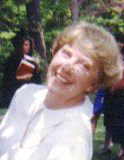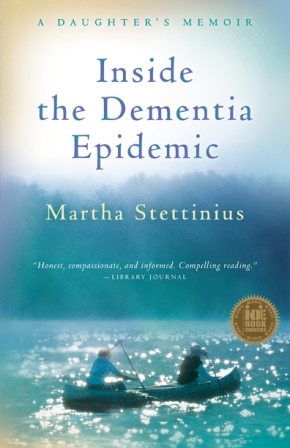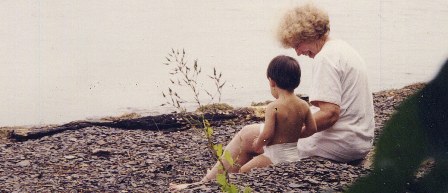To Hospitalize or Not at the End of Life—How Things Can Fall Apart
 Sunday, January 20, 2013 at 03:37PM
Sunday, January 20, 2013 at 03:37PM Thank you for following my new blog. My mother, Judy, passed away December 1st at age 80 after 10 years of living with Alzheimer’s disease and vascular dementia. My husband, Ben, and I were at her side nearly around-the-clock in her nursing home for three days as she  declined suddenly from heart failure. Her last days were traumatic, unfortunately—not at all the peaceful passing I had hoped for (and thought I had prepared for, as her caregiver). I’d like to share with you here what went wrong—what I could have done differently as her caregiver to have helped her experience less pain and discomfort, and what her facility might have done differently. (However, as I write in my book, as caregivers we “know what we know when we know it,” and are never perfect. Especially with death, there is only so much we can anticipate.) I hope that this information will help you with your own planning for end-of-life decisions.
declined suddenly from heart failure. Her last days were traumatic, unfortunately—not at all the peaceful passing I had hoped for (and thought I had prepared for, as her caregiver). I’d like to share with you here what went wrong—what I could have done differently as her caregiver to have helped her experience less pain and discomfort, and what her facility might have done differently. (However, as I write in my book, as caregivers we “know what we know when we know it,” and are never perfect. Especially with death, there is only so much we can anticipate.) I hope that this information will help you with your own planning for end-of-life decisions.
Palliative and Comfort Care
Over the past 8 years, Mom has lived with me, in an assisted living facility, a rehab center, a “memory care” facility, and the nursing home. For the past 2 years she has been unable to speak, walk, or feed herself, and, in the last six months, ate only pureed food and became less responsive. Over the summer I made it clear to the head nurse and social worker that Mom should be “palliative and comfort care only.” Mom told me years ago that she wanted no invasive treatments or procedures, no intubation, no feeding tubes, even no antibiotics if she got repeated bouts of pneumonia (a common occurrence in people with advanced dementia). Eight years ago she signed a Living Will with me as her Health Care Proxy. This past summer I sensed that she had reached the point where her quality of life was such that she would not want to linger.
I assumed that “palliative and comfort care only” meant that Mom would never be sent to the hospital or subjected to tests, that the nursing home would provide any care she needed to remain comfortable. I was wrong. Looking back, I made too many assumptions. For example, I assumed that once we agreed that Mom should be “palliative and comfort care only” that the staff would make sure there was a “Do Not Hospitalize” order in her chart. I know now that the two things are very different. Only 2% of nursing home residents have a “Do Not Hospitalize” order in their charts. I needed be very specific and ask the head nurse or social worker to get the doctor to sign such paperwork. I could also have asked to see the paperwork myself. (Verify, verify!)
MOLST forms
 More importantly, I should have double-checked my mother’s MOLST (Medical Orders for Life-Sustaining Treatment) form—a neon-pink form that serves as a more detailed Living Will, with sections for end-of-life decisions such as whether or not the person would want to be intubated, given a feeding tube, or be sent to the hospital. (For information about your state’s MOLST form, Google MOLST and your state.)
More importantly, I should have double-checked my mother’s MOLST (Medical Orders for Life-Sustaining Treatment) form—a neon-pink form that serves as a more detailed Living Will, with sections for end-of-life decisions such as whether or not the person would want to be intubated, given a feeding tube, or be sent to the hospital. (For information about your state’s MOLST form, Google MOLST and your state.)
A couple of months before my mother died, a graduate student who was interning as a social worker at my mother’s nursing home asked me to come in and sign my mother’s most recent MOLST. I waited in the lobby for the graduate student, whom I’d never met before, expecting that we would sit down for a few minutes and go over it, but the young woman just handed it to me and asked for my signature in a very brusque manner. I could tell she was in a major hurry. So, since I had studied closely my mother’s previous MOLST forms, and assumed that this one would have the same information, I simply signed the back of the form. Big mistake. I found out after Mom died that the whole inside of the form was blank, including the section on whether or not I wanted Mom to go to the hospital. A MOLST form allows the option of “Do not send to the hospital unless pain or severe symptoms cannot be otherwise controlled.” From what I understand, my mother’s symptoms when she was sent to the hospital alone in the middle of the night could have been controlled in the nursing home—oxygen for difficulty breathing, and pain medication for discomfort. I know it’s challenging for a third-shift nurse to reach the nursing home doctors and get approval for morphine or other treatment in the middle of the night, but I thought that that was what “palliative and comfort care only” meant—Mom would receive all of the care she needed within the nursing home, at any hour. I would then call in hospice to help supervise and augment that care.
As I suggested to the nursing home’s director a few weeks after Mom died, it might have been a good idea for the staff to go over the MOLST form with me during one of the many care plan meetings I attended. Family caregivers need a little encouragement to talk about end-of-life issues. We don’t always understand what different terms mean, and we need clear communication from facility staff. And since a MOLST form does not allow the option of “no hospitalization, ever,” we need a chance to talk with staff about what can be done for comfort care in the nursing home, and what might require a hospital.
That blank MOLST form started a spiral of unfortunate events.
Hospitalization Three Days Before Death
In late November Mom seemed fine, if a bit more tired than normal. She had a very mild cough, and I agreed that she should receive antibiotics in case it was the beginning of pneumonia. She still made eye contact, shared her beautiful smile, and seemed to respond to what people said to her. I enjoyed our visits together, and just a few days before she died she was able to eat the pureed Thanksgiving dinner I brought her. Later that evening we sat together in the nursing home’s lobby by their Christmas tree, holding hands as she gazed from me to the tree’s soft, white lights, my miniature Schnauzer in her lap. Two nights later, however, the nurse on duty sent my mother to the E.R. at 3 a.m. with difficulty breathing. The nurse left a message on my cell phone, but since it was the middle of the night I didn’t notice the message until my mother had been in the hospital alone for 5 hours. The nurse did not follow the instructions in my mother’s chart to call my husband’s cell phone if they could not get a hold of me. By the time I got to my mother in the E.R. (after I drove carpool—I’m a sandwich generation mom after all), my mother had been admitted to the hospital, been subjected to a battery of tests, and was about to be given Saltine crackers to see if she could swallow solid food (she would have choked on them). Mom was sitting up and perky, smiling at me and the nurses, on oxygen with no sign of distress. When her pureed breakfast finally arrived at 11 a.m., I spoon-fed her and she ate heartily. Her doctor from the nursing home stopped in, listened to her lungs and heart, and told me that it wasn’t pneumonia. A man of few words, he said, “I think it’s her heart. We’ll stop the antibiotics, and I’ll start her on morphine when she gets back to Woodside.” With that he swung out of the room. No empathetic murmurings that my mother was dying. I had to figure that out on my own.
And then, as Mom and I waited for the ambulance to transport her back to the nursing home, she threw up her lunch. With muscles weak from the dementia, she could not cough hard enough to get the vomit out of her throat. The nurses tried, twice, to suction it out, but said it was out of reach. The ambulance crew arrived. Mom seemed uncomfortable but not in terrible distress. It never occurred me—or to the nurses, apparently—to delay Mom’s transport until she was more comfortable, to ask the doctor to order the morphine to start right there in the hospital. I trusted the nurses to do whatever Mom needed. Looking back, I should have pressed for pain medication right then. But like most caregivers, I’m not a medical professional, and I didn’t recognize the beginnings of distress when I saw it. The ambulance crew whisked Mom away. I hoped that Mom would receive more attention back at the nursing home, with staff who knew her well.
Mom arrived at the nursing home in acute distress, her eyes bugging out, her breath rapid with a gurgling sound. Once transferred to her bed, she was given oxygen and the morphine was ordered. It takes some time to get a controlled substance available in a nursing home. We waited another half hour for the morphine to arrive. By then Mom’s “stats” were extremely low—poor oxygen levels in her blood, and an erratic heartbeat. A nurse told me it might be “a matter of hours.” When I asked the head nurse, the one I knew best, if that sounded right to her, she tried to make a joke of it. “I wish I had a crystal ball, but I don’t.”
To me, the saddest part of Mom’s death was witnessing distress that might have been avoided. It took another couple of hours for her stats to go back to normal and for her to relax. The whole time I held her hand and tried to reassure her as best I could. Just a horrible time.
I called hospice, but they could not send the intake nurse until the next morning. And even then, it turned out, a hospice nurse or aide could only be there an hour a day. The rest of the time it was just me and my husband (who took the days off from work) by my mother’s side, with a few short visits from friends. I don’t know about you, but I thought hospice meant having a knowledgeable person at my side throughout my mother’s active dying—not just a few hours week. But unless your loved one has reserved a spot in a stand-alone hospice facility, where hospice staff are available around-the-clock, you are basically on your own as a caregiver. At my mother’s nursing home, it was left to my husband and me to figure out if my mother needed more morphine, and to chase down the nurses to administer it if they were busy doing other things. The quality of her care in those 3 days seemed to hinge on the compassion and personalities of individual staff members—not on any facility-wide agreement about what attention and support dying residents and their family members deserved. Some nurses were wonderful; others not so much. Meanwhile we felt unmoored, helpless.
Balancing Life in the Moment with Planning for Death
Mom’s final two days were relatively peaceful, thankfully, and she passed away one morning when Ben and I had gone home to get some much-needed sleep. I came in to sit with her and say good-bye.
What I’m trying to remember now is not the panic and fear in my mother’s eyes before the morphine took hold, but the many moments of peace and grace we felt together over the past 8 years I was her caregiver. I know now that pain and distress in the dying process cannot always be avoided, but I also know that, for my mother, those hours of distress represented a tiny fraction of her life with dementia. She was still living with dementia—still taking in the beauty of the world, still sharing moments of affection—right up to the morning in the hospital when she threw up her breakfast and it all went downhill.
With end-of-life planning, the hard part, I think, is balancing our desire to enjoy our time with our loved one in the moment, free of any morbid concerns, with taking the time to think through and anticipate the unpleasantness of death. Even with the best planning we might not be able to protect them from unnecessary trauma—but we can try. In the same way, we might be able to lessen our own feelings of fear and panic as we sit in a bedside vigil.
Believe me, I’m not berating myself over any mistakes I made in my mother’s final days—I know I did the best I could with what I knew—but I do wish that I had paid a little more attention to communication with the facility staff, such as the MOLST form, and that I’d asked a few more questions. I wish that Mom had never been sent to the hospital, that she had received morphine in the nursing home— part of “comfort and palliative care only”—as soon as she had difficulty breathing. Certainly if she had aspirated vomit in the nursing home she would not have had to wait so long before receiving morphine. I hope that the image of her face in distress will fade, that I’ll remember instead our quiet moments together, her hand in mine.
I’m sorry, Mom, and I love you.


















Reader Comments (2)
I hope I successfully just now posted the blog site to FaceBook; your sharing is profound in the importance and fullness of the information, insights from your experience, and love, full-bloomed. With many thanks!
Sharon, certified EAH Trainer
Sharon, thank you for writing such a lovely message in response to my blog post. For some reason I didn't see this comment until now, so please accept a belated thank you! -- Martha